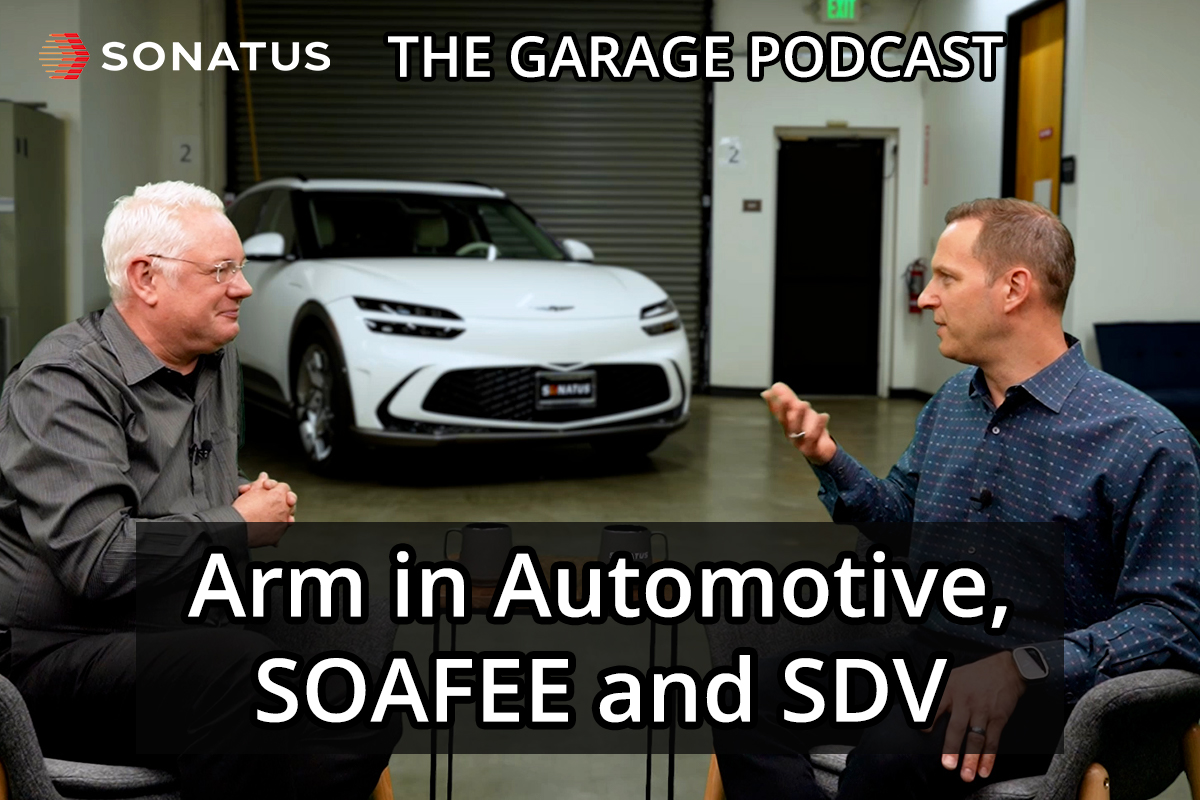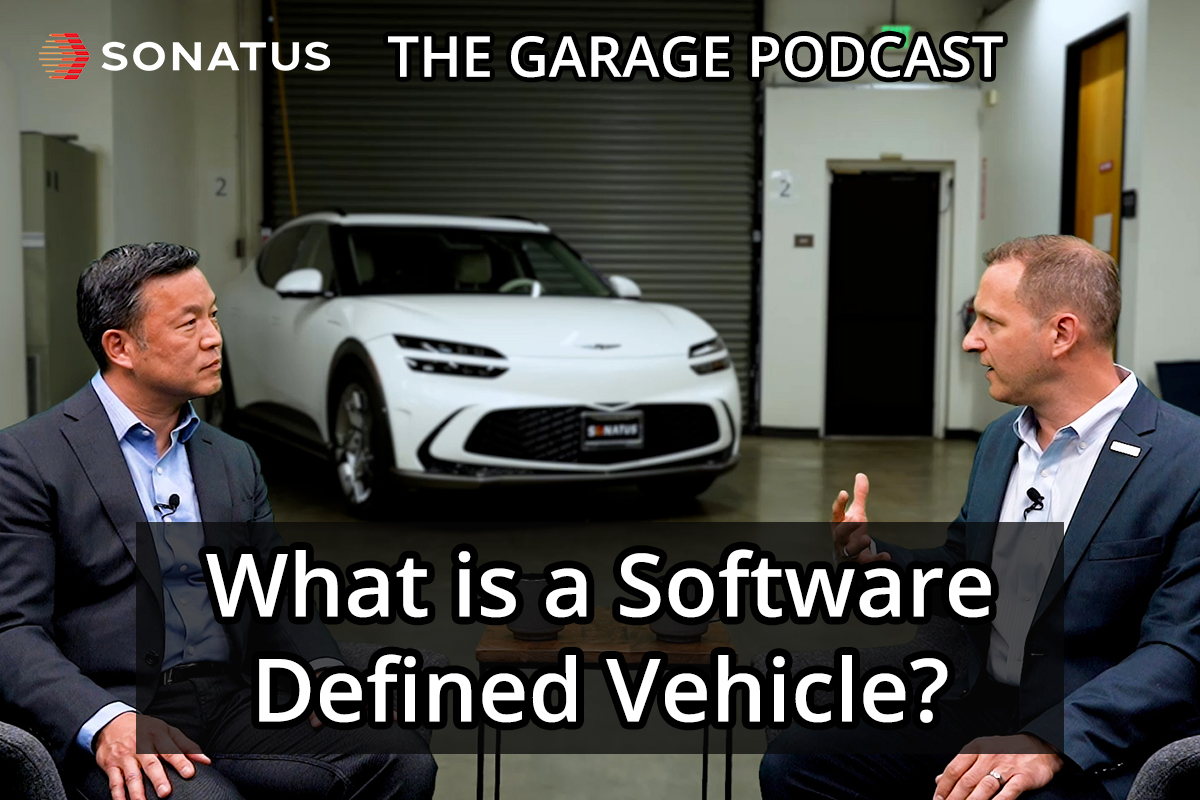Welcome
JOHN: Hello, and welcome to The Garage. In today’s episode, use cases for software-defined vehicles. Let’s go! Welcome to today’s episode of The Garage. I’m John Heinlein, Chief Marketing Officer from Sonatus. Today we’re going to talk all about software-defined vehicles and what are some of the many use cases and the powerful features that software-defined vehicles enable.
Guest Introduction
JOHN: Today, my guest is Yu Fang, who is the Chief Technology Officer and Co-Founder of Sonatus. Yu, thanks for joining me in The Garage.
YU: Thank you. Thank you. Yeah, I’m very happy to join the podcast. And just a little bit about myself, so I’m Co-Founder and CTO at Sonatus. So I’m an engineer at heart. I have been working on a range of different products from hardware systems to software, both embedded and cloud-based software to solve a range of problems throughout my career. So very happy to be working on cutting-edge solutions for the automotive industry at Sonatus.
JOHN: Yeah, it’s interesting because, you know, cars today, it’s not just about the car itself, but it’s about software in the cloud, as well, and that whole spectrum of things, I think you bring a lot of great background from that.
YU: Absolutely.
Episode overview: Software’s impact across the vehicle life cycle
JOHN: So today’s topic, we’re going to talk about software-defined vehicles, and while we, in our first episode, we talked about what does it take to achieve a software-defined vehicle. Today, I think we’re going to dig into what are some of the many use cases that software-defined vehicles enable. And I thought the way we’d do that is to think about it from the lifecycle of the vehicle, starting with the design process, design and engineering of the vehicle, through into the production process and end-of-line testing. Then into after-sales, both the consumer’s experience, things like connected services, and, finally, value-added, perhaps data monetization services that’s available.
YU: Yep. That’s great. Yep.
Design and engineering
JOHN: So let’s begin with the first of these, which is the design and engineering process for vehicles. How do you see software-defined vehicles bringing value to that phase of the design?
YU: Traditionally, the deployment cycle for a vehicle is relatively long, however, recently, that the development cycle is being accelerated and becomes shorter and shorter. And OEMs have the desire to continuously bring in new features and new functionalities, even very late in the development cycle of a vehicle. This is especially true with the development of EVs, but the traditional way of doing that is through engineering change order, which takes a long time to do and is costly. So, therefore, there is a need for leveraging software to be able to experiment with new features and functionalities very quickly, even very late in the development cycle.
JOHN: That’s great, and we were talking with a number of OEMs, and there, they say that there’s a lot of different aspects of tuning their vehicle, that they would love that flexibility, so that sounds like a very powerful tool.
YU: Yeah, absolutely. Absolutely. Because, you know, you don’t need to flash a whole bunch of ECUs every time that you need to make a small tuning to an algorithm in your battery management system, for example.
Production
JOHN: So for the second topic, let’s talk about the production process itself because the production process is very complicated. You’re physically making metal, but you’re also needing to test the electronics and test the vehicle as it’s getting through the process. How does the software-defined vehicle benefit the production process?
YU: So, testing is very important in the production process and you have to guarantee that every vehicle goes out of the factory is fully functional and safe. Traditionally, you need a lot of very expensive equipment, and you need to have test engineers working on the manufacturing floor to operate this equipment in order to do the testing. However, even with that, it’s still difficult to perform a full range of tests on the vehicle because the production line has to move quickly. So there is a need to bring in new ways of testing the vehicle automatically.
JOHN: So almost like a vehicle self-test, giving the vehicle instructions to test itself, in a way.
YU: Yeah, exactly. So allowing the vehicle itself to have the capability to perform a full range of tests, so that you can operate all the testing remotely.
JOHN: Yeah, we were talking with some OEMs, and we hypothesize that, you can imagine having a whole parking lot full of vehicles ready to go on the train or the ship to go to be delivered, only to find you had a test escape or some sort of manufacturing problem. It would really be great if you could actually test those vehicles without having to walk around to every one of them individually, so it feels like software-defined vehicles have the potential to help that kind of problem.
YU: Absolutely. That’s a very good point.
Service and maintenance
JOHN: Let’s move on to the third topic, which is after sales. There’s a lot of opportunities for software and vehicles to be used in many ways after sales. So let’s talk about some of those examples.
YU: So, the whole service and maintenance area is hugely important both for the consumers as well as for the OEMs. So from a consumer perspective, they want to know when something happens to their vehicle so that it can be maintained, so it doesn’t lead to a significant breakdown. And for the OEM, they want to understand how their vehicle is performing and be able to catch problems earlier so that they can avoid recall, which is very costly.
JOHN: Yeah, you’re hearing examples one after another where when a recall occurs they can be in the billions with a “B”, billions of dollars of costs, so it seems like if we can avoid those by finding issues early or even perhaps fixing them in software, that could be compelling.
YU: Absolutely. This is definitely a problem that can be solved with the software by being able to proactively monitor different aspects of the vehicle operation, as well as consumers’ behavior of using that vehicle in order to detect problems early.
JOHN: Yeah, one of the things I also think about is from a consumer perspective because OEMs are really focused on brand loyalty and a good post-ownership experience, is that one of the things you hate is you take your vehicle into the shop and you say it’s having this problem, and the technician looks at it. They spend a lot of time, maybe you have to take time off work, and they say “I can’t find the problem, there’s nothing wrong.” You’d really love to be able to give the consumer a better experience of knowing what’s going on and it may be that software can help us better understand how the vehicle is behaving, which can save OEMs cost as well.
YU: Absolutely. Absolutely. This can also be tied into the management of the parts, so that when the consumer brings their vehicle in, the parts are already available, and then the maintenance can be done right away.
JOHN: Yeah. To think about the way vehicles are done, where maybe you have a problem that occurs only sporadically or only in certain conditions. Trying to reproduce that when you bring your car in for service seems to be very challenging, so I think software has the potential to really improve this service aspect.
YU: Yes.
Consumer personalization
JOHN: What other aspects of post-sales ownership do you think makes sense?
YU: So another area we think that the software can bring a lot of value is the whole personalization aspect of the vehicle. So OEMs are bringing a lot of innovations into sort of a user experience area, right Through their infotainment system. And they’re giving the consumers a lot of choices, however, different consumers have different preferences of those choices, and sometimes it’s difficult for those consumers to figure out exactly what’s the right knobs to set in order to get to the state that they really like. So, therefore, being able to introduce some kind of intelligence into the personalization area so that the vehicle can figure out what the consumer actually prefers and be able to set the vehicle to the way exactly they want.
JOHN: Right. This seems to speak to the broader connected services aspect where being able to configure your car or personalize it for how you want it, versus how your spouse wants it, for example. We saw Mercedes roll out a solution recently that’s giving consumers the ability to make some amount of customization and some amount of routines, if you will, that do certain features. So I think that’s a very new area that’s going to become more and more popular and perhaps more and more required by consumers.
YU: Absolutely. There is a lot of opportunity in this area.
Value-added services and data monetization
JOHN: I think the fourth aspect of software-defined vehicles and how they can help is on value-added services and potentially the opportunity for data monetization. Today, if you think about our smartphones, and why we liked them so much, it’s not because they’re an amazing device – and they are an amazing device – but it’s really because of the rich app ecosystem, the rich ability to bring in other companies and other vendors to add value to the device. Whereas, typically, today, cars are quite a closed ecosystem, so it seems to me like we have the ability with software to really unlock the ecosystem to add value to the user and the driver’s experience.
YU: Absolutely. So there’s tremendous potential in this area. So start with data, right? So there’s a lot of insight that can be gained from all kinds of data that’s available from the vehicle, and those data can help many different companies in the ecosystem in order to serve their customers better, and, in turn, help OEMs to gain value from those data.
JOHN: Right. We hear examples of consumers, for example, having better insurance pricing because they’re a safer driver or so on. Well, historically, that’s been a kind of a hardware module you plug into the car, but going forward, we think you can probably do those kinds of things in software and many other things like them. So when we think about data, it’s not like big brother watching over your shoulder but we’re actually adding value and doing something that’s benefiting the consumer and maybe even helping them save cost.
Fleet management such as rental cars
YU: Absolutely. Absolutely. One good example is a rental car fleet. Where not only by providing the data to the rental car company, but providing a service to them, so that they know after a particular rental session, how the vehicle was used, whether or not there’s any maintenance required, and so on and so forth. That can help the rental car companies to be able to manage their fleet much more efficiently and cost-effectively, and, in turn, the OEM can gain some value from that.
JOHN: That’s right. That’s interesting, and I think when you think about rental car companies, you know, when a car comes in returning from rental, all they can do is look at and say, well, there’s no dents, I guess it must be okay. But actually, you don’t know if it was driven like a race car or was driven very conservatively. So it potentially gives them the ability to give someone who’s a safe driver, maybe even a better price, knowing that their vehicles are going to be better taken care of, for example.
Next-generation telematics
JOHN: So this seems like it’s generally talking about next-generation fleet telematics. Telematics has been out for a long time providing certain data to fleet owners, but, today, the telematics approach is a little bit rudimentary and this sounds like it unlocks the ability to do much more advanced, much more customizable, configurable, telematics.
YU: Absolutely. So meaning building services that is tailored for a particular use case, instead of a more general solution, right? But you can also go one step further than that. You can even provide services that proactively maintain the vehicle, for example. Again, using the rental car company, as an example. So after a particular rental session, you could even proactively perform certain actions to the vehicle, so you bring it to a known state. So when the next renter comes in, the vehicle is already ready for them, right? If there is any tuning or any maintenance that can be done remotely, you could also do that automatically without the need of a technician to operate on the vehicle.
JOHN: Interesting. Yeah, I’m always observing when I have a rental car that I am always seeing the radio presets and the Bluetooth settings from the previous renters, and I think it kind of diminishes the experience of the customer because you don’t feel like it’s your car. You feel like you’re borrowing someone else’s car. So it’s fun to think about unlocking better features for the rental car companies, and then you also mentioned that there are different kinds of fleets. There’s more private leasing fleets where you lease a car for a period of time, there may be delivery fleets, rental car fleets, and many other things, so they may have different requirements, and so the ability to customize that seems very powerful.
YU: Yes, absolutely. So you have trucking companies that may have very different needs, and even within trucking companies, there are some trucking companies who are specialized in container moving, but some others are specialized in delivery, so they also may have their own needs. And all of this can be served from OEMs by providing different services to those customers.
JOHN: Well, thanks very much, Yu. This has been a great conversation. I really appreciate you joining us here in The Garage.
YU: Thank you so much, John. It’s been fun.
Summary
JOHN: So we hope you enjoyed today’s episode. We explored today the use cases for software-defined vehicles and looking at the entire lifecycle of the vehicle from the design and engineering process through to production and end-of-line test, into post sales service and support and user experience, and finally into value-added and monetizing services that software unlocks. I think the potential for software in vehicles is only just beginning. We’re seeing massive opportunities to evolve vehicles and we hope this has given you a sense of some of those capabilities. We look forward to seeing you in another episode of The Garage very soon. Thank you so much.




